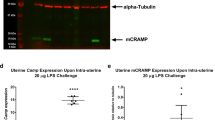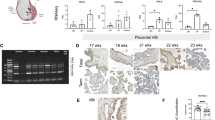Abstract
The typically lysosomal family of cysteine cathepsin proteases has been implicated in the development of the placenta in particular, from studies in the mouse. Here, we analysed overall expression, regulation and presence of transcript isoforms of cysteine cathepsins during human extra-embryonic development. All 11 family members are expressed in human placental tissues, and many are differentially regulated during gestation. Several cysteine cathepsins exhibit deregulated expression levels in placentas from pregnancies complicated by pre-eclampsia. The localization of cathepsin B predominantly in placental and decidual macrophages suggests a role in the physiological functions of these cells in mediating villous angiogenesis and decidual apoptosis. Cathepsin L levels are highest in a subpopulation of invasive cytotrophoblasts. Reflecting the expression pattern of two murine cathepsins, these data give insights into the evolutionary conservation of cathepsin function that is not necessarily exhibited by gene pairs defined by highest sequence similarity. Furthermore, cathepsin L protein localization in uterine epithelial cells demonstrates the in vivo occurrence of intranuclear cathepsin L isoforms. The zonally restricted expression of cathepsin in the syncytiotrophoblast may be important for the metabolic breakdown of maternal nutrients. Overall, the distribution and abnormal expression levels in pre-eclamptic placentas indicate that cysteine cathepsins may play important roles during normal placentation and in the etiology of pre-eclampsia.






Similar content being viewed by others
References
Benirschke K, Kaufmann P (2000) Pathology of the human placenta, 4th edn. Springer, Berlin Heidelberg New York
Pijnenborg R, Bland JM, Robertson WB, Dixon G, Brosens I (1981) The pattern of interstitial trophoblastic invasion of the myometrium in early human pregnancy. Placenta 2:303–316
Librach CL, Werb Z, Fitzgerald ML, Chiu K, Corwin NM, Esteves RA, Grobelny D, Galardy R, Damsky CH, Fisher SJ (1991) 92-kD type IV collagenase mediates invasion of human cytotrophoblasts. J Cell Biol 113:437–449
Feinberg RF, Kao LC, Haimowitz JE, Queenan JT, Wun TC, Strauss JF III, Kliman HJ (1989) Plasminogen activator inhibitor types 1 and 2 in human trophoblasts: PAI-1 is an immunocytochemical market of invading trophoblasts. Lab Invest 61:20
Huppertz B, Kertschanska S, Demir AY, Frank HG, Kaufmann P (1998) Immunohistochemistry of matrix metalloproteinases (MMP), their substrates, and their inhibitors (TIMP) during trophoblast invasion in the human placenta. Cell Tissue Res 291:133–148
Graham CH, Lala PK (1992) Mechanisms of placental invasion of the uterus and their control. Biochem Cell Biol 70:867–874
Sol-Church K, Picerno GN, Stabley DL, Frenck J, Xing S, Bertenshaw GP, Mason RW (2002) Evolution of placentally expressed cathepsins. Biochem Biophys Res Commun 293:23–29
Deussing J, Kouadio M, Rehman S, Werber I, Schwinde A, Peters C (2002) Identification and characterization of a dense cluster of placenta-specific cysteine peptidase genes and related genes on mouse chromosome 13. Genomics 79:225–240
Turk V, Turk B, Turk D (2001) Lysosomal cysteine proteases: facts and opportunities. EMBO J 20:4629–4633
Ahn K, Yeyeodu S, Collette J, Madden V, Arthur J, Li L, Erickson AH (2002) An alternate targeting pathway for procathepsin L in mouse fibroblasts. Traffic 3:147–159
Joyce JA, Hanahan D (2004) Multiple roles for cysteine cathepsins in cancer. Cell Cycle 3:1516–1619
Afonso S, Romagnano L, Babiarz B (1997) The expression and function of cystatin C and cathepsin B and cathepsin L during mouse embryo implantation and placentation. Development 124:3415–3425
Roth W, Deussing J, Botchkarev VA, Pauly-Evers M, Saftig P, Hafner A, Schmidt P, Schmahl W, Scherer J, Anton-Lamprecht I, Von Figura K, Paus R, Peters C (2000) Cathepsin L deficiency as molecular defect of furless: hyperproliferation of keratinocytes and pertubation of hair follicle cycling. FASEB J 14:2075–2086
Deussing J, Roth W, Saftig P, Peters C, Ploegh HL, Villadangos JA (1998) Cathepsins B and D are dispensable for major histocompatibility complex class II-mediated antigen presentation. Proc Natl Acad Sci U S A 95:4516–4521
Divya R, Chhikara P, Mahajan VS, Datta Gupta S, Chauhan SS (2002) Differential activity of cathepsin L in human placenta at two different stages of gestation. Placenta 23:59–64
Warwas M (1981) Isozymes of cathepsin B1 in developing human placenta. Experientia 37:966–967
Sawicki G, Warwas M (1989) Cathepsin H from human placenta. Acta Biochim Pol 36:343–351
Matsui K, Yuyama N, Akaiwa M, Yoshida NL, Maeda M, Sugita Y, Izuhara K (2002) Identification of an alternative splicing variant of cathepsin C/dipeptidyl-peptidase I. Gene 293:1–7
Nakanishi T, Ozaki Y, Blomgren K, Tateyama H, Sugiura-Ogasawara M, Suzumori K (2005) Role of cathepsins and cystatins in patients with recurrent miscarriage. Mol Hum Reprod 11:351–355
Santamaria I, Velasco G, Pendas AM, Paz A, Lopez-Otin C (1999) Molecular cloning and structural and functional characterization of human cathepsin F, a new cysteine proteinase of the papain family with a long propeptide domain. J Biol Chem 274:13800–13809
Velasco G, Ferrando AA, Puente XS, Sanchez LM, Lopez-Otin C (1994) Human cathepsin O. Molecular cloning from a breast carcinoma, production of the active enzyme in Escherichia coli, and expression analysis in human tissues. J Biol Chem 269:27136–27142
Pijnenborg R, Vercruysse L, Verbist L, Van Assche FA (1998) Interaction of interstitial trophoblast with placental bed capillaries and venules of normotensive and pre-eclamptic pregnancies. Placenta 19:569–575
Sambrook J, Fritsch EF, Maniatis T (1989) Molecular cloning: a laboratory manual, 2nd edn. Cold Spring Harbor Press, Cold Spring Harbor
Gong Q, Chan SJ, Bajkowski AS, Steiner DF, Frankfater A (1993) Characterization of the cathepsin B gene and multiple mRNAs in human tissues: evidence for alternative splicing of cathepsin B pre-mRNA. DNA Cell Biol 12:299–309
Zhou Y, Damsky CH, Fisher SJ (1997) Preeclampsia is associated with failure of human cytotrophoblasts to mimic a vascular adhesion phenotype. One cause of defective endovascular invasion in this syndrome? J Clin Invest 99:2152–2164
DiFederico E, Genbacev O, Fisher SJ (1999) Preeclampsia is associated with widespread apoptosis of placental cytotrophoblasts within the uterine wall. Am J Pathol 155:293–301
Pidoux G, Gerbaud P, Laurendeau I, Guibourdenche J, Bertin G, Vidaud M, Evain-Brion D, Frendo JL (2004) Large variability of trophoblast gene expression within and between human normal term placentae. Placenta 25:469–473
Lewis MP, Clements M, Takeda S, Kirby PL, Seki H, Lonsdale LB, Sullivan MH, Elder MG, White JO (1996) Partial characterization of an immortalized human trophoblast cell-line, TCL-1, which possesses a CSF-1 autocrine loop. Placenta 17:137–146
Hemberger M, Himmelbauer H, Ruschmann J, Zeitz C, Fundele R (2000) cDNA subtraction cloning reveals novel genes whose temporal and spatial expression indicates association with trophoblast invasion. Dev Biol 222:158–169
Seth P, Mahajan VS, Chauhan SS (2003) Transcription of human cathepsin L mRNA species hCATL B from a novel alternative promoter in the first intron of its gene. Gene 321:83–91
Arora S, Chauhan SS (2002) Identification and characterization of a novel human cathepsin L splice variant. Gene 293:123–131
Lah TT, Kokalj-Kunovar M, Drobnic-Kosorok M, Babnik J, Golouh R, Vrhovec I, Turk V (1992) Cystatins and cathepsins in breast carcinoma. Biol Chem Hoppe Seyler 373:595–604
Mohanam S, Jasti SL, Kondraganti SR, Chandrasekar N, Lakka SS, Kin Y, Fuller GN, Yung AW, Kyritsis AP, Dinh DH, Olivero WC, Gujrati M, Ali-Osman F, Rao JS (2001) Down-regulation of cathepsin B expression impairs the invasive and tumorigenic potential of human glioblastoma cells. Oncogene 20:3665–3673
Krueger S, Kellner U, Buehling F, Roessner A (2001) Cathepsin L antisense oligonucleotides in a human osteosarcoma cell line: effects on the invasive phenotype. Cancer Gene Ther 8:522–528
Szpaderska AM, Frankfater A (2001) An intracellular form of cathepsin B contributes to invasiveness in cancer. Cancer Res 61:3493–3500
Premzl A, Zavasnik-Bergant V, Turk V, Kos J (2003) Intracellular and extracellular cathepsin B facilitate invasion of MCF-10A neoT cells through reconstituted extracellular matrix in vitro. Exp Cell Res 283:206–214
Wang B, Shi GP, Yao PM, Li Z, Chapman HA, Bromme D (1998) Human cathepsin F. Molecular cloning, functional expression, tissue localization, and enzymatic characterization. J Biol Chem 273:32000–32008
Bestvater F, Dallner C, Spiess E (2005) The C-terminal subunit of artificially truncated human cathepsin B mediates its nuclear targeting and contributes to cell viability. BMC Cell Biol 6:16
Kobayashi H, Schmitt M, Goretzki L, Chucholowski N, Calvete J, Kramer M, Gunzler WA, Janicke F, Graeff H (1991) Cathepsin B efficiently activates the soluble and the tumor cell receptor-bound form of the proenzyme urokinase-type plasminogen activator (Pro-uPA). J Biol Chem 266:5147–5152
Rajakumar A, Doty K, Daftary A, Markovic N, Conrad KP (2005) Expression of the von Hippel Lindau (pVHL) protein in placentae from normal pregnant women and women with preeclampsia. Placenta (in press). http://www.DOI 10.1016/j.placenta.2005.04.002
Blankenship TN, Enders AC (1997) Trophoblast cell-mediated modifications to uterine spiral arteries during early gestation in the macaque. Acta Anat (Basel) 158:227–236
Khan S, Katabuchi H, Araki M, Nishimura R, Okamura H (2000) Human villous macrophage-conditioned media enhance human trophoblast growth and differentiation in vitro. Biol Reprod 62:1075–1083
Anteby EY, Natanson-Yaron S, Greenfield C, Goldman-Wohl D, Haimov-Kochman R, Holzer H, Yagel S (2005) Human placental Hofbauer cells express sprouty proteins: a possible modulating mechanism of villous branching. Placenta 26:476–483
Demir R, Kayisli UA, Seval Y, Celik-Ozenci C, Korgun ET, Demir-Weusten AY, Huppertz B (2004) Sequential expression of VEGF and its receptors in human placental villi during very early pregnancy: differences between placental vasculogenesis and angiogenesis. Placenta 25:560–572
Myatt L, Eis AL, Brockman DE, Kossenjans W, Greer I, Lyall F (1997) Inducible (type II) nitric oxide synthase in human placental villous tissue of normotensive, pre-eclamptic and intrauterine growth-restricted pregnancies. Placenta 18:261–268
Laskowska M, Leszczynska-Gorzelak B, Oleszczuk J (2003) Placental angiotensin II receptor AT1R in normotensive patients and its correlation between infant birth weight. Eur J Obstet Gynecol Reprod Biol 109:166–170
Im E, Venkatakrishnan A, Kazlauskas A (2005) Cathepsin B regulates the intrinsic angiogenic threshold of endothelial cells. Mol Biol Cell 16(8):3488–3500
Guicciardi ME, Deussing J, Miyoshi H, Bronk SF, Svingen PA, Peters C, Kaufmann SH, Gores GJ (2000) Cathepsin B contributes to TNF-alpha-mediated hepatocyte apoptosis by promoting mitochondrial release of cytochrome c. J Clin Invest 106:1127–1137
Foghsgaard L, Wissing D, Mauch D, Lademann U, Bastholm L, Boes M, Elling F, Leist M, Jaattela M (2001) Cathepsin B acts as a dominant execution protease in tumor cell apoptosis induced by tumor necrosis factor. J Cell Biol 153:999–1010
Hempstock J, Cindrova-Davies T, Jauniaux E, Burton GJ (2004) Endometrial glands as a source of nutrients, growth factors and cytokines during the first trimester of human pregnancy: a morphological and immunohistochemical study. Reprod Biol Endocrinol 2:58
Ishida M, Ono K, Taguchi S, Ohashi S, Naito J, Horiguchi K, Harigaya T (2004) Cathepsin gene expression in mouse placenta during the latter half of pregnancy. J Reprod Dev 50:515–523
Nakajima A, Kataoka K, Takata Y, Huh NH (2000) Cathepsin-6, a novel cysteine proteinase showing homology with and co-localized expression with cathepsin J/P in the labyrinthine layer of mouse placenta. Biochem J 349(Pt 3):689–692
Goulet B, Baruch A, Moon NS, Poirier M, Sansregret LL, Erickson A, Bogyo M, Nepveu A (2004) A cathepsin L isoform that is devoid of a signal peptide localizes to the nucleus in S phase and processes the CDP/Cux transcription factor. Mol Cell 14:207–219
Acknowledgements
The authors would like to thank Drs. M. Sullivan and S. Walker for materials and help with the informatics analysis. This work was supported by an MRC Career Development Award to M.H. and a Wellcome Trust postdoctoral fellowship to S.L.W.
Author information
Authors and Affiliations
Corresponding author
Rights and permissions
About this article
Cite this article
Varanou, A., Withington, S.L., Lakasing, L. et al. The importance of cysteine cathepsin proteases for placental development. J Mol Med 84, 305–317 (2006). https://doi.org/10.1007/s00109-005-0032-2
Received:
Accepted:
Published:
Issue Date:
DOI: https://doi.org/10.1007/s00109-005-0032-2




